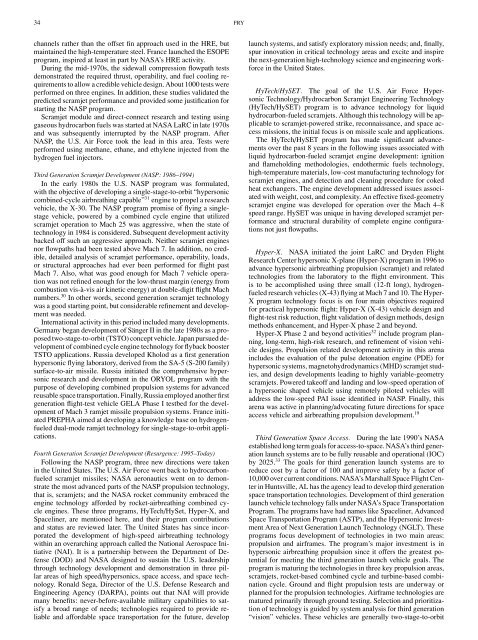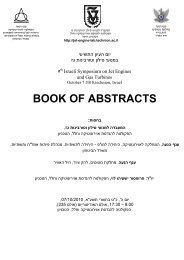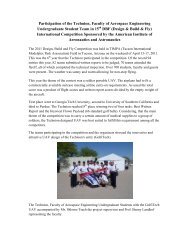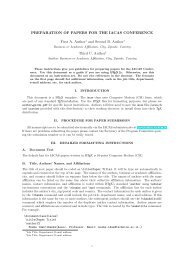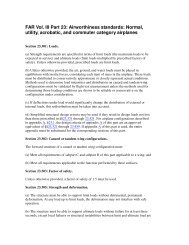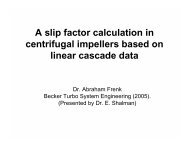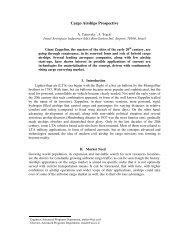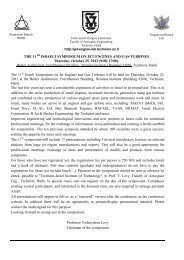A Century of Ramjet Propulsion Technology Evolution - Faculty of ...
A Century of Ramjet Propulsion Technology Evolution - Faculty of ...
A Century of Ramjet Propulsion Technology Evolution - Faculty of ...
Create successful ePaper yourself
Turn your PDF publications into a flip-book with our unique Google optimized e-Paper software.
34 FRY<br />
channels rather than the <strong>of</strong>fset fin approach used in the HRE, but<br />
maintained the high-temperature steel. France launched the ESOPE<br />
program, inspired at least in part by NASA’s HRE activity.<br />
During the mid-1970s, the sidewall compression flowpath tests<br />
demonstrated the required thrust, operability, and fuel cooling requirements<br />
to allow a credible vehicle design. About 1000 tests were<br />
performed on three engines. In addition, these studies validated the<br />
predicted scramjet performance and provided some justification for<br />
starting the NASP program.<br />
Scramjet module and direct-connect research and testing using<br />
gaseous hydrocarbon fuels was started at NASA LaRC in late 1970s<br />
and was subsequently interrupted by the NASP program. After<br />
NASP, the U.S. Air Force took the lead in this area. Tests were<br />
performed using methane, ethane, and ethylene injected from the<br />
hydrogen fuel injectors.<br />
Third Generation Scramjet Development (NASP: 1986–1994)<br />
In the early 1980s the U.S. NASP program was formulated,<br />
with the objective <strong>of</strong> developing a single-stage-to-orbit “hypersonic<br />
combined-cycle airbreathing capable” 31 engine to propel a research<br />
vehicle, the X-30. The NASP program promise <strong>of</strong> flying a singlestage<br />
vehicle, powered by a combined cycle engine that utilized<br />
scramjet operation to Mach 25 was aggressive, when the state <strong>of</strong><br />
technology in 1984 is considered. Subsequent development activity<br />
backed <strong>of</strong>f such an aggressive approach. Neither scramjet engines<br />
nor flowpaths had been tested above Mach 7. In addition, no credible,<br />
detailed analysis <strong>of</strong> scramjet performance, operability, loads,<br />
or structural approaches had ever been performed for flight past<br />
Mach 7. Also, what was good enough for Mach 7 vehicle operation<br />
was not refined enough for the low-thrust margin (energy from<br />
combustion vis-à-vis air kinetic energy) at double-digit flight Mach<br />
numbers. 30 In other words, second generation scramjet technology<br />
wasagood starting point, but considerable refinement and development<br />
was needed.<br />
International activity in this period included many developments.<br />
Germany began development <strong>of</strong> Sänger II in the late 1980s as a proposed<br />
two-stage-to-orbit (TSTO) concept vehicle. Japan pursued development<br />
<strong>of</strong> combined cycle engine technology for flyback booster<br />
TSTO applications. Russia developed Kholod as a first generation<br />
hypersonic flying laboratory, derived from the SA-5 (S-200 family)<br />
surface-to-air missile. Russia initiated the comprehensive hypersonic<br />
research and development in the ORYOL program with the<br />
purpose <strong>of</strong> developing combined propulsion systems for advanced<br />
reusable space transportation. Finally, Russia employed another first<br />
generation flight-test vehicle GELA Phase I testbed for the development<br />
<strong>of</strong> Mach 3 ramjet missile propulsion systems. France initiated<br />
PREPHA aimed at developing a knowledge base on hydrogenfueled<br />
dual-mode ramjet technology for single-stage-to-orbit applications.<br />
Fourth Generation Scramjet Development (Resurgence: 1995–Today)<br />
Following the NASP program, three new directions were taken<br />
in the United States. The U.S. Air Force went back to hydrocarbonfueled<br />
scramjet missiles; NASA aeronautics went on to demonstrate<br />
the most advanced parts <strong>of</strong> the NASP propulsion technology,<br />
that is, scramjets; and the NASA rocket community embraced the<br />
engine technology afforded by rocket-airbreathing combined cycle<br />
engines. These three programs, HyTech/HySet, Hyper-X, and<br />
Spaceliner, are mentioned here, and their program contributions<br />
and status are reviewed later. The United States has since incorporated<br />
the development <strong>of</strong> high-speed airbreathing technology<br />
within an overarching approach called the National Aerospace Initiative<br />
(NAI). It is a partnership between the Department <strong>of</strong> Defense<br />
(DOD) and NASA designed to sustain the U.S. leadership<br />
through technology development and demonstration in three pillar<br />
areas <strong>of</strong> high speed/hypersonics, space access, and space technology.<br />
Ronald Sega, Director <strong>of</strong> the U.S. Defense Research and<br />
Engineering Agency (DARPA), points out that NAI will provide<br />
many benefits: never-before-available military capabilities to satisfy<br />
a broad range <strong>of</strong> needs; technologies required to provide reliable<br />
and affordable space transportation for the future, develop<br />
launch systems, and satisfy exploratory mission needs; and, finally,<br />
spur innovation in critical technology areas and excite and inspire<br />
the next-generation high-technology science and engineering workforce<br />
in the United States.<br />
HyTech/HySET. The goal <strong>of</strong> the U.S. Air Force Hypersonic<br />
<strong>Technology</strong>/Hydrocarbon Scramjet Engineering <strong>Technology</strong><br />
(HyTech/HySET) program is to advance technology for liquid<br />
hydrocarbon-fueled scramjets. Although this technology will be applicable<br />
to scramjet-powered strike, reconnaissance, and space access<br />
missions, the initial focus is on missile scale and applications.<br />
The HyTech/HySET program has made significant advancements<br />
over the past 8 years in the following issues associated with<br />
liquid hydrocarbon-fueled scramjet engine development: ignition<br />
and flameholding methodologies, endothermic fuels technology,<br />
high-temperature materials, low-cost manufacturing technology for<br />
scramjet engines, and detection and cleaning procedure for coked<br />
heat exchangers. The engine development addressed issues associated<br />
with weight, cost, and complexity. An effective fixed-geometry<br />
scramjet engine was developed for operation over the Mach 4–8<br />
speed range. HySET was unique in having developed scramjet performance<br />
and structural durability <strong>of</strong> complete engine configurations<br />
not just flowpaths.<br />
Hyper-X. NASA initiated the joint LaRC and Dryden Flight<br />
Research Center hypersonic X-plane (Hyper-X) program in 1996 to<br />
advance hypersonic airbreathing propulsion (scramjet) and related<br />
technologies from the laboratory to the flight environment. This<br />
is to be accomplished using three small (12-ft long), hydrogenfueled<br />
research vehicles (X-43) flying at Mach 7 and 10. The Hyper-<br />
X program technology focus is on four main objectives required<br />
for practical hypersonic flight: Hyper-X (X-43) vehicle design and<br />
flight-test risk reduction, flight validation <strong>of</strong> design methods, design<br />
methods enhancement, and Hyper-X phase 2 and beyond.<br />
Hyper-X Phase 2 and beyond activities 32 include program planning,<br />
long-term, high-risk research, and refinement <strong>of</strong> vision vehicle<br />
designs. <strong>Propulsion</strong> related development activity in this arena<br />
includes the evaluation <strong>of</strong> the pulse detonation engine (PDE) for<br />
hypersonic systems, magnetohydrodynamics (MHD) scramjet studies,<br />
and design developments leading to highly variable-geometry<br />
scramjets. Powered take<strong>of</strong>f and landing and low-speed operation <strong>of</strong><br />
ahypersonic shaped vehicle using remotely piloted vehicles will<br />
address the low-speed PAI issue identified in NASP. Finally, this<br />
arena was active in planning/advocating future directions for space<br />
access vehicle and airbreathing propulsion development. 19<br />
Third Generation Space Access. During the late 1990’s NASA<br />
established long term goals for access-to-space. NASA’s third generation<br />
launch systems are to be fully reusable and operational (IOC)<br />
by 2025. 33 The goals for third generation launch systems are to<br />
reduce cost by a factor <strong>of</strong> 100 and improve safety by a factor <strong>of</strong><br />
10,000 over current conditions. NASA’s Marshall Space Flight Center<br />
in Huntsville, AL has the agency lead to develop third generation<br />
space transportation technologies. Development <strong>of</strong> third generation<br />
launch vehicle technology falls under NASA’s Space Transportation<br />
Program. The programs have had names like Spaceliner, Advanced<br />
Space Transportation Program (ASTP), and the Hypersonic Investment<br />
Area <strong>of</strong> Next Generation Launch <strong>Technology</strong> (NGLT). These<br />
programs focus development <strong>of</strong> technologies in two main areas:<br />
propulsion and airframes. The program’s major investment is in<br />
hypersonic airbreathing propulsion since it <strong>of</strong>fers the greatest potential<br />
for meeting the third generation launch vehicle goals. The<br />
program is maturing the technologies in three key propulsion areas,<br />
scramjets, rocket-based combined cycle and turbine-based combination<br />
cycle. Ground and flight propulsion tests are underway or<br />
planned for the propulsion technologies. Airframe technologies are<br />
matured primarily through ground testing. Selection and prioritization<br />
<strong>of</strong> technology is guided by system analysis for third generation<br />
“vision” vehicles. These vehicles are generally two-stage-to-orbit


